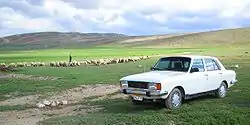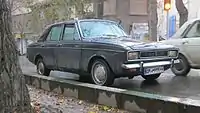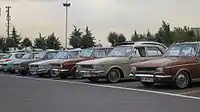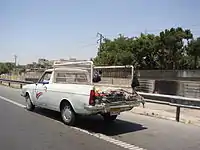Paykan
The Paykan (Persian: پيکان meaning Arrow) is the first Iranian made car produced by Iran Khodro (formerly called "Iran National") between 1967 and 2005. The car was very popular in Iran from its introduction until its discontinuation. It is often colloquially referred as the Iranian chariot.
| Paykan | |
|---|---|
.jpg.webp) | |
| Overview | |
| Manufacturer | Iran Khodro |
| Also called | Rootes Arrow Hillman Hunter Dodge Husky Chrysler Vogue |
| Production |
|
| Body and chassis | |
| Body style | 4-door Saloon 5-door Estate 2-door Coupe utility (Pick up) |
| Layout | Front-engine, rear-wheel-drive |
| Related | Peugeot ROA IKCO Arisun |
| Powertrain | |
| Engine | |
| Transmission | Manual transmission |
| Dimensions | |
| Wheelbase | 98 in (2,489 mm) (Saloon) |
| Length | 171 in (4,343 mm) (Saloon) |
| Width | 63 in (1,600 mm) (Saloon) |
| Height | 56 in (1,422 mm) (Saloon) |
| Curb weight | 2,100 lb (953 kg) (Saloon) |

The Paykan was a Hillman Hunter built under licence, but had some unique body work and locally-developed variants (most notably, the pickup, which used a different body shell from the one sold elsewhere).
History
The design was introduced to Iran by Mahmoud Khayami, co-founder and, by then, owner of the Iran Khodro (formerly called "Iran National") company and factory, who accurately predicted that Iran was in need of a simple "no-frills" motorcar within the price range of ordinary people.
In 1967, Rootes began exporting Hillman Hunters to Iran Khodro in "complete knock down" (CKD) kit form, for assembly in Iran. By the mid-1970s, full-scale manufacturing of the car (minus the engine) had started in Iran.
In 1977, Roy Axe designed a new Paykan facelift model using many interior and exterior parts from the Chrysler Alpine.
In 1978, Peugeot took over the Rootes company after it collapsed under the ownership of Chrysler Europe; a year later, Peugeot ended Hillman Hunter production in Ireland. Following this, the Paykan's engine production tooling was moved to Iran and was in full-scale manufacturing under Peugeot licence. This ended in 2005 with the final Paykan leaving the assembly line.
Irankhodro tried to replace Paykan with a so called "New Paykan" but Peugeot did not agree with the naming. This revealed the fact that the intellectual ownership of the Paykan brand and logo still belongs to the PSA (Peugeot Société Anonyme) as a legacy of the demise of Rootes group.
Design
Although the Paykan was based on a 1966 Hillman Hunter, there were many changes and modifications made to it over the years – notably the substitution of the original 1725cc Rootes engine with a Peugeot 504-derived unit. The modifications to the exterior included revised headlights and taillights. A Paykan Pickup was also offered.[1] There was another pickup truck based on the Hillman Hunter sold in South Africa – the Dodge Husky – but the two models used different bodies. The South African version has a thicker B-pillar and retains the saloon's lines along the side panels. The tailgate and rear window are also subtly different.
The Iranian government reportedly offered Iran Khodro a large cash incentive to end Paykan production by 2005, labelling the car as an environmental hazard because of its unacceptably high fuel consumption. During its last years, the order backlog was nearly two years long.
The Samand, commonly referred to as the "New Paykan", is currently being produced by Iran Khodro as a modern substitute for the Paykan class of cars. In 2005, Iran Khodro announced that it had sold the discontinued Paykan's motorcar production line to the Khartoum Transport Company in Sudan, while car-parts production for the Paykan still continues by third party manufacturers in Iran.
 A Paykan seen in Tehran.
A Paykan seen in Tehran. A 1971 Paykan DeLuxe.
A 1971 Paykan DeLuxe. A Paykan gathering in Northern Tehran.
A Paykan gathering in Northern Tehran. A Paykan Pickup.
A Paykan Pickup.
See also
References
- Iran Khodro Paykan Pick up, tocmp.org Archived 2016-04-15 at the Wayback Machine Retrieved 15 February 2016